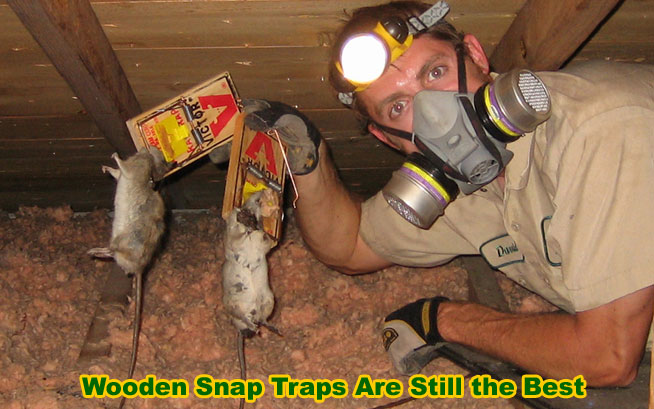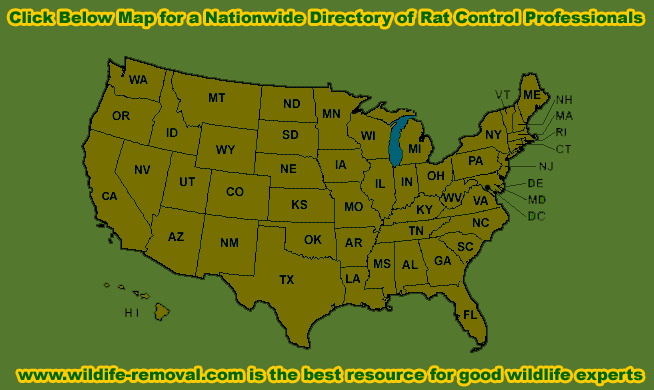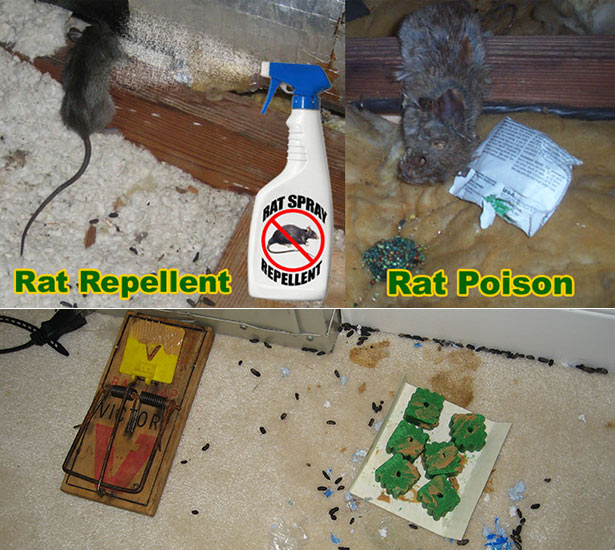How to Get Rid of Rats in the Attic
I built this website as a resource for people who want to get rid of a rat problem. I am a rodent control expert with 15 years of experience, and I am friends with hundreds of other rodent removal experts. This website provides practical tips and resources for you to solve any problem you may have with a rat in your attic or building.
Why get rid of rats? Well, for starters, they spread diseases. Some people just don't like hearing noises in the attic at night. But they can also cause quite a bit of damage with their chewing and with the feces they leave behind. But solving a rat problem is not simple! I'm going to outline your various options below, so that you can make an informed decision about how to solve your rat problem in your attic or home.
Option 1: Do it Yourself
If you want to get rid of rats in the attic, you need to follow a series of steps:
Step 1:
Find out how rats are getting inside the building. This is absolutely crucial! Those rats are entering your home and attic somehow. You will NEVER solve your rat problem unless you find ALL the entry points. Every single last one. One little failure, one missed spot, and you will have rats in your attic or house forever. You must inspect the whole structure, from the ground up, including all portions of the roof, and the plumbing system. Check vents, eaves, roof joints, plumbing stacks, AC chases, the chimney, EVERYTHING. You must be completely thorough. An intimate knowledge of rat behavior and building architecture helps a great deal. Know what signs to look for - brown staining and grease at entry points, gnawing, etc. Also, inspect in the attic, where you will see rat trails that will help you identify entry points, and you'll spot rat damage that you'll want to fix, such as gnawed wires or pipes. Hearing sounds in the attic can also pinpoint areas of high activity. This page will help explain the inspection process in more detail: Rat Inspection.

Step 2:
Seal up all the entry points. That's right, seal them up first, even if there are many rats currently inside the building. It's very important that you do it this way. If you leave the entry holes open, and then begin trapping or excluding the rats, guess what? Open holes mean more and more rats will keep coming in, and the job will never end. And here's another important point - the rats are much easier to trap once the exits have been sealed off. And if you intend to do an exclusion with a one-way rat door, then you have to seal all entry/exit holes first. Read more about repairs on this page: Rat Repairs.
Step 3:
Trap and remove the rats. You have three options here. First, you can use the standard lethal snap traps. Second, you can use live cage traps. Third, you can install a one-way funnel door exit on the primary rat entry/exit hole, if you have identified it. I have used all of these methods. I do care about being humane to all wildlife, but when it comes to rats, which breed incredibly quickly and have a very short life span, and have good memories and gnawing abilities, I must say that I absolutely do use the lethal snap traps in the attic. I have found this method is to be the most effective, and it's more humane than a slow, painful death by poisoning. Set the traps on the rodent runways, not haphazardly. Trap placement is absolutely key. Bait doesn't even matter, but I do use peanut butter on my trap pans. Brand of trap does matter, and I like the old Victor wooden traps. Check the traps frequently and remove and dispose of any trapped rats, to avoid odor problems. Read more about the art of rat trapping here: How To Trap Rats.
Animal Lovers Take Note: If you catch rats alive and relocate them outside, or if you block them out of the attic, studies have proven that without their normal home and shelter, they die or fall to predators very quickly. Thus, trying to get rats out of the attic alive is pointless. I am confident that my method is the most humane approach reasonably possible.

Step 4:
Clean up after the rats. It's important that you decontaminate and deodorize the attic after you have removed the rats. Rats and rat feces can cause various health problems. Learn more about: Rat Diseases. Rats leave behind a strong pheromone scent which attracts new rats to the attic. This scent is in the urine and gland grease that rats leave behind. This scent encourages new rats to gnaw their way into your attic, so it's important to get rid of this scent. And other animals, such as snakes, track this scent too. I wear full biohazard gear and HEPA filter mask and vacuum up the droppings, replace soiled insulation, and fog the whole attic with a special enzyme-based cleaner that kills the germs, pathogens, mold, and scent of the poop and urine. Read more about the process: Rat Decontamination.
I should mention that the principles here also apply to all rodents, including how to get rid of mice in the attic. A mouse can be a little easier to trap than a rat, but using these principles, it doesn't matter. Mice behave in the same way, so to get rid of a mouse, do the same things, just be aware that they can get in even smaller holes, like the size of a dime, and that you need to use smaller mouse traps. Removing a mouse in the attic can be even more challenging than rats. I have made this website: how to get rid of mice in the attic to address mice.
Option 2: Hire a Professional
Rat control work is definitely not easy! The instructions above are correct, but doing the job correctly is very difficult. Experience matters a whole lot! I did many rat jobs, dozens of jobs over my first couple of years, and even though I'm very observant and careful and hard-working, I messed up again and again, and my customers continued to have rat problems, and I had to re-do my jobs over and over. It wasn't until I had a LOT of experience under my belt that I got good at solving rat problems in attics and buildings PERMANENTLY. I honestly recommend that you hire a seasoned professional to do your rat control work. And for goodness' sake DO NOT hire a regular exterminator company or your usual pest control company. They will just throw some poison in the attic, and try to sign you up for a never-ending monthly or quarterly contract. They WANT to NEVER solve the problem, so they can keep charging you. You want a wildlife control professional who will stop the source of the problem, and seal off all entry points. I have compiled a list of good experts. Click your state on this map in order to hire a professional in your area. This website lists rodent removal experts in 657 different US cities and towns.

Here are some example cities: Akron OH | Albany NY | Albuquerque NM | Allentown PA | Anaheim CA | Annapolis MD | Ann Arbor MI | Arlington VA | Athens Clarke GA | Atlanta GA | Augusta GA | Austin TX | Baltimore MD | Baton Rouge LA | Bellingham WA | Birmingham AL | Boca Raton FL | Boston MA | Bradenton FL | Bridgeport CT | Buffalo NY | Canton OH | Charleston SC | Charleston WV | Charlotte NC | Charlottesville VA | Chattanooga TN | Chicago IL | Cincinnati OH | Clarksville TN | Cleveland OH | Colorado Springs CO | Columbia SC | Columbus GA | Columbus OH | Corpus Christi TX | Dallas TX | Dayton OH | Denver CO | Des Moines IA | Detroit MI | Elizabeth NJ | Eugene OR | Fairfax County VA | Fayetteville NC | Fort Lauderdale FL | Fort Myers FL | Fort Worth TX | Fresno CA | Gainesville FL | Grand Rapids MI | Green Bay WI | Greensboro NC | Greenville SC | Hackensack NJ | Harrisburg PA | Hartford CT | Houston TX | Huntsville AL | Indianapolis IN | Jackson MS | Jacksonville FL | Jersey City NJ | Kalamazoo MI | Kansas City KS | Kansas City MO | Knoxville TN | Lakeland FL | Lansing MI | Las Vegas NV | Lawrenceville GA | Lexington KY | Little Rock AR | Los Angeles CA | Louisville KY | Lowell MA | Macon GA | Madison WI | Manchester NH | Marietta GA | Melbourne FL | Memphis TN | Miami FL | Milwaukee WI | Minneapolis MN | Mobile AL | Montgomery AL | Myrtle Beach SC | Naples FL | Nashville TN | Nassau County NY | Newark NJ | New Orleans LA | New York City NY | Norfolk VA | Oak Forest IL | Oakland CA | Ocala FL | Oklahoma City OK | Olympia WA | Orlando FL | Paterson NJ | Philadelphia PA | Phoenix AZ | Pittsburgh PA | Plano TX | Portland OR | Port St Lucie FL | Providence RI | Quakertown PA | Raleigh NC | Reading PA | Reno NV | Richmond CA | Richmond VA | Riverside CA | Rochester NY | Sacramento CA | Salinas CA | Salt Lake City UT | San Antonio TX | San Bernardino CA | San Diego CA | San Francisco CA | San Jose CA | Scranton PA | Seattle WA | South Bend IN | Springfield MA | Springfield MO | Sterling Heights MI | St Louis MO | St Paul MN | St Petersburg FL | Suffolk County NY | Syracuse NY | Tacoma WA | Tallahassee FL | Tampa FL | The Villages FL | Toledo OH | Toronto Canada | Trenton NJ | Tucson AZ | Tulsa OK | Virginia Beach VA | Waco TX | Washington DC DC | Waterbury CT | Westchester NY | West Palm Beach FL | Wilmington DE | Winston Salem NC
Option 3: Habitat Modification & Prevention
There's a reason you have rats on your property and in your house. Your property is in an area of the country that has a rat population (that includes most urban or suburban areas), and your property or house has features that are attractive to rats. Most commonly, this means that your property has food, water, and shelter. Rats like a safe place to live and scavenge and hide and have a nest of young and store food, and so on. A building makes a great location! It's warm and dry and safe, and in proximity to food, and so on. There's a reason rats are common in cities, but not out in the forest. Take these Rat Prevention steps:
- Eliminate debris such as garbage or compost piles on the property.
- Seal all gaps, with steel, leading anywhere into the house.
- Don't leave out pet food or open garbage cans.
- Bird feeders can attract rats, as can fruit trees.
- A pet cat or two might help. But I have seen rat infestations in homes with cats.
The following remedies do not work:
- Planting or spreading mint leaves - that's a myth.
- Use of rat repellants such as ammonia, mothballs, or cat urine.
- Use of ultrasonic sound emitters (proven fraudulent by the FTC).
- Use of fake owls or hawk decoys.
Option 4: Use Rat Poison
So you've read this far, for some reason. Okay then, I'm here to tell you something very important: RAT POISON IS THE WORST THING YOU CAN DO to address a rat problem. Here are several of the reasons why you don't want to Poison a Rat:
- It's not effective - Not all the rats will find the poison, not all the ones that find it will eat the poison (rats are amazingly cautious), and not all that eat it will die (many have become resistant, and they must eat a lethal dose).
- It's a temporary fix - even if the poison does kill rats, new rats will keep coming and coming. Heck, new ones will come to eat the dead rat carcasses. As long as there is ample space and nearby food, you'll have rats.
- It's inhumane - you may not like rats, you may want to kill them and that's fine. But poison is a slow and painful death. Why not use much more effective lethal snap traps?
- You'll wind up with rotting rat carcasses in your attic or walls. If a rat dies of poison, it's going to die in your house, where it spends most of its time. Some poison sellers spread an absolute hogwash myth about rats going outside to die near water. What a crock! Several times a week, I'm called out to remove dead rats from buildings, in insulation, walls, etc, because someone, often a pest control company, put out rat poison. A rotting rat will stink up the whole house - it smells horrible.
If you want to kill the rats, click here for better methods of How To Kill a Rat.

Option 5: Use Rat Repellent
Ha ha ha ha ha ha. You will find animal repellents of all kinds sold out there. "Squirrel-Repel" and "Snake-Be-Gone" and "Rat-Away" and so on. These products are totally BOGUS. Go ahead and try them, try all of them, and when you find out that these cheap gimmicks do absolutely nothing, start properly at step 1 at the top of this page. Most such repellents are made of naphthalene (mothball flakes) which DO NOT WORK and which just poisons the environment, or stinks up your attic, or harms your health! Don't use them! Or the products contain sulfur or coyote urine. These are the same gimmick ingredients used in all generic animal repellents. They are a scam, and they do not work! I have tested all of these products over many years in the field, just to see, and they are all totally ineffective. I've been to so many homes in which homeowners tried repellents first, it's ridiculous. Oh, and forget anything that claims "ultrasonic sound" or vibrations or anything, those have been certified as grade-a scams by the federal trade commission. Read more about Rat Repellent here.



